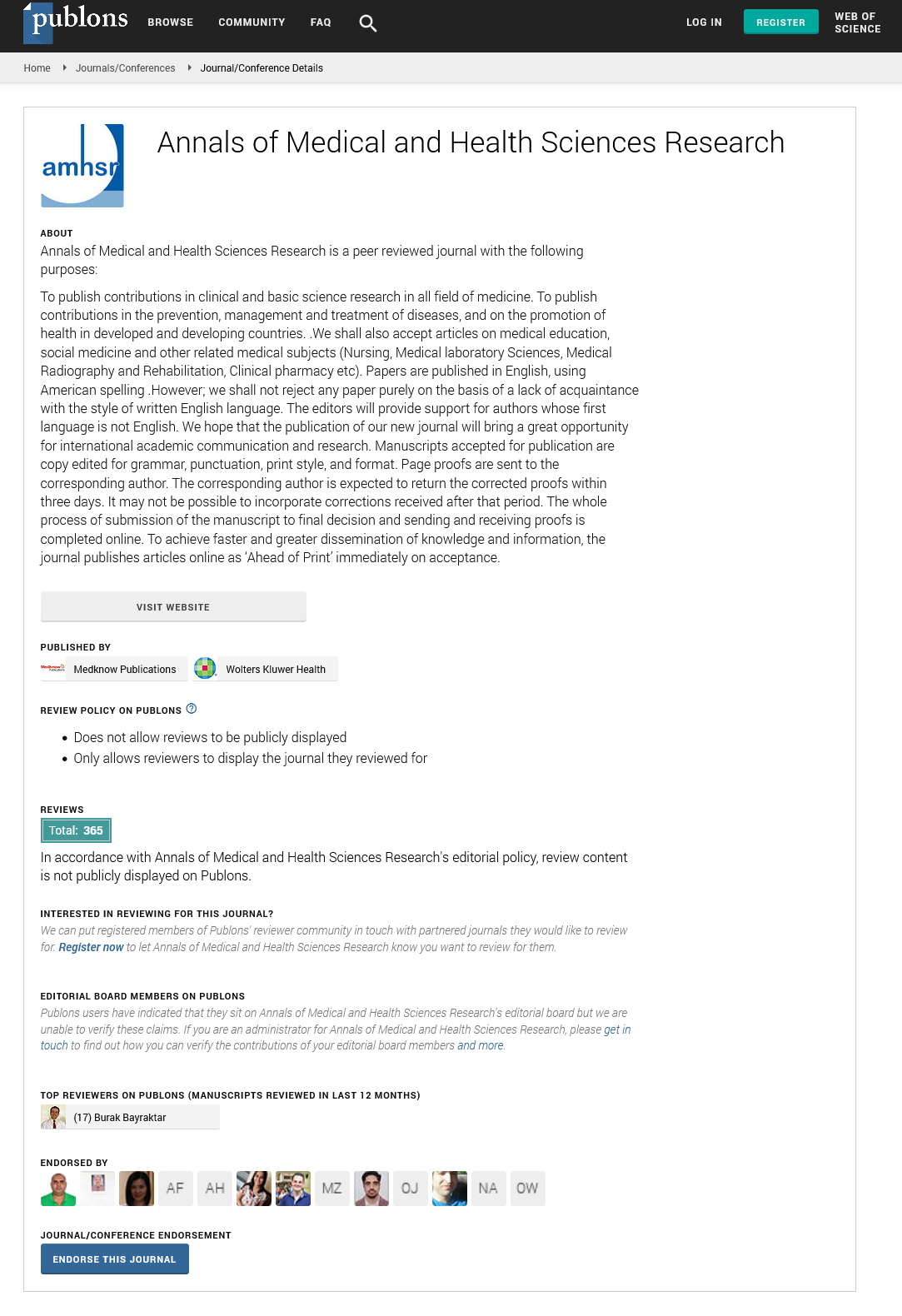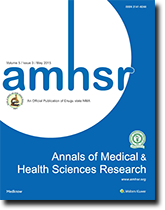A Case of Posterior Shoulder Dislocation with Ipsilateral Humeral Shaft Fracture
- *Corresponding Author:
- Dr. Sanjay Meena,
Department of Orthopedics, Maulana Azad Medical College and Associated Hospitals, New Delhi - 110 029, India.
E-mail: sanjaymeena@hotmail.com
Citation: Sharma P, Meena S, Rastogi D, Chowdhury B.A case of posterior shoulder dislocation with ipsilateral humeral shaft fracture. Ann Med Health Sci Res 2014;4:314-6.
Abstract
Posterior shoulder dislocations are rare and represent 2–5% of all traumatic shoulder dislocation. A combination of this injury with ipsilateral humeral shaft fracture is extremely rare event. We here report a case of posterior shoulder dislocation with ipsilateral fracture shaft of humerus following road traffic accident. Through this report, we highlight the rarity of the condition and review the available literature on the subject. We also emphasize the importance of complete physical and radiological examination when dealing with such cases to ensure early detection and its subsequent treatment.
Keywords
Glenohumeral dislocation, Humeral shaft fracture, Posterior shoulder dislocation
Introduction
Posterior dislocation of the shoulder is a rare entity and represents approximately 2–5% of all traumatic shoulder dislocations.[1,2] A combination of humeral shaft fracture with ipsilateral posterior glenohumeral dislocation is an even rarer event, with only a few confirmed reports in the literature.[3‑6] In most of these reports, the shoulder dislocation has been diagnosed late, which led to unsatisfactory patient outcome. High index of suspicion and early diagnosis by adequate clinical radiological examination is required to prevent osteonecrosis of the humeral head and ensure satisfactory joint functional recovery.
This report presents a case of posterior shoulder dislocation with ipsilateral humeral shaft fracture.
Case Report
A 31‑year‑old male was brought to our emergency department following road traffic accident. He was riding a motorcycle when he was hit by car from the left side. He complained of pain and deformity over the right arm. On physical examination, there was swelling and tenderness over middle third arm. There was no distal neurovascular deficit. No injury was found in his other limb. In view of the above clinical findings, a radiograph of the right shoulder with arm was suggested. Radiographs revealed posterior shoulder dislocation with greater tuberosity fracture with humeral shaft fracture [Figure 1]. U slab was then applied, and the patient was taken to operation theatre after a routine blood investigations.
Under general anesthesia, firstly a schanz pin was inserted into the proximal fragment. Traction was given through the pin and medial pressure was given over humeral head. Subsequently, the proximal fragment was rotated externally, which lead to reduction of the joint. Open reduction and internal fixation of fracture shaft humerus was done with nine hole low contact dynamic compression plate by posterior approach [Figure 2]. Radial nerve was identified, and the plate was slided beneath it. The neurologic examination for radial nerve was normal before and after the procedure. Postoperatively, limb was immobilized in an arm sling, and only little flexion and extension was allowed. Three weeks postoperatively the patient was allowed to start range of motion exercises and muscle strengthening exercises of the shoulder. Complete bony union was evident on the radiographs after 2 months [Figure 3]. At 1 year follow‑up, patient has joined his occupation. His shoulder flexion is 100°, abduction 80° with 18° of external rotation.
Discussion
Posterior shoulder dislocation is rare injury due to the presence of strong soft tissues behind the joint. They usually occur after uncontrolled muscular contractions, as in seizure disorders or epilepsy, electric shock therapy, or spasticity.[2,7] Traumatic posterior glenohumeral dislocations may occur from an axial force applied to the upper extremity in the vulnerable position of adduction, internal rotation and forward elevation. In our patient, the fall on the outstretched arm may have caused the injury, but the exact mechanism and sequence of injury is difficult to ascertain.
In patients having ipsilateral humeral shaft fracture, shoulder symptoms may sometimes be confused by the physician due to the associated fracture, shoulder contusion or rotator cuff injury. Physician should be aware that fracture shaft of humerus can be associated with a neighboring joint dislocation/ fracture. Emphasis should be given on the importance of clinical and radiological examination of the joint above and below the injury. Posterior shoulder dislocations are common unrecognized injury. Hawkins et al. explained the delay in diagnosis by an average of 1 year in 75% of cases.[8] There should be suspicion whenever a patient reports shoulder pain and inability to move the shoulder after axial loading on an adducted internally rotated arm or following a high energy trauma. The classic physical findings of posterior dislocation include decreased anterior prominence of the humeral head, increased palpable posterior prominence of the humeral head below the acromion, increased palpable prominence of the coracoid, marked limitation of abduction, and complete absence of external rotation with a fixed internal rotation deformity.[5] However in patients with associated fracture humerus such signs may not be apparent.
Radiologically, an anterior dislocation of the shoulder is easily diagnosed, whereas a posterior dislocation is notoriously easy to miss. Inadequate radiological evaluation represents perhaps the greatest barrier to the successful diagnosis of posterior shoulder dislocation. The main reason for a missed diagnosis is the failure to do adequate radiographs. One can identify most lesions about the shoulder with anteroposterior and scapular lateral orthogonal views, but the untrained eyes may miss subtle signs of posterior glenohumeral dislocation. Typical findings on the anteroposterior film include absence of half‑moon crescentic overlap created by humeral head and glenoid fossa, a “vacant” glenoid cavity, loss of parallelism between the articular surfaces of the glenoid cavity and humeral head, which is referred to as “Moloney’s line” and internal rotation of the humerus, and an impaction fracture.[9]
A complete radiological evaluation in such patients must include the trauma series described by neer: An anteroposterior view in the scapular plane, a scapular lateral view and axillary view. A definite diagnosis is obtained only with an axillary view. Unfortunately, it was not obtained in this patient due fracture shaft humerus. However, axillary view can be obtained in such patients by splinting the fracture before obtaining the radiographs. If any suspicion arises, proper plain views or a computed tomography (CT) scan can demonstrate a posterior shoulder dislocation, and a CT scan also defines the extent of displacement and the osseous abnormalities in such a situation. CT scan was not obtained in our patient as the dislocation was evident on the anteroposterior view.
Delay in diagnosis of posterior dislocations of the shoulder has been frequently reported. Proposed explanations for the delay in diagnosis include failure of the evaluating physician to include the condition in the differential diagnosis, suboptimal radiographic evaluation and interpretation, and coincidental injuries such as fractures that can confound the patient’s presentation. A delay in diagnosis and subsequent treatment of posterior shoulder dislocation or fracture‑dislocation has attendant risks of non‑union, subsequent humeral head collapse, avascular necrosis, post‑traumatic arthritis, and muscle wasting.[9,10] This jeopardizes the potential effectiveness of any orthopedic intervention. Thus, the delay in diagnosis, the complexity of these injuries and their rare combination with fracture shaft humerus may all lead to a significant morbidity associated with posterior glenohumeral dislocations Emergency medical staff should be aware of such a condition and the importance of early referral for proper intervention.
Management is difficult in such cases. We were able to lever the humerus head into the glenoid with the help of schanz pin inserted into the proximal fragment. However it may sometimes prove difficult, and the patient may require open reduction in chronic neglected cases.[5]
Conclusion
Posterior dislocation of the shoulder with ipsilateral humeral shaft fracture is rare; it is an important condition to identify. Awareness of this condition, high index of suspicion coupled complete physical and radiological examinations, should greatly increase the chance of early diagnosis and treatment.
Acknowledgements
We thank the patient for giving us permission to publish this report. This patient presented in the emergency of Sushruta trauma center and was managed in the same institute.
Source of Support: Nil.
Conflict of Interest: None declared.
References
- Detenbeck LC. Posterior dislocations of the shoulder. J Trauma 1972;12:183-92.
- Matsen FA, Lippit SB, Bertlesen A, Rockowood AC, Wirth MA, Titelman RM. Glenohumeral instability. In: Rockwood CA, Matsen FA, Wirth MA, Lippitt SB, Fehringer EV, Sperling JW, editors. The Shoulder. 3rd ed., Vol. 2. Philadelphia: Saunders; 2004. p. 655-794.
- Naresh S, Chapman JA, Muralidharan T. Posterior dislocation of the shoulder with ipsilateral humeral shaft fracture: A very rare injury. Injury 1997;28:150-2.
- Sauve PS, Redfern DJ, Pike J. Locked posterior dislocation of the shoulder with ipsilateral humeral shaft fracture ? A management option. Injury Extra 2004;35:23-6.
- Li HH, Liu SQ, Peng H. A neglected posterior fracture dislocation of the shoulder with ipsilateral distal humeral shaft fracture. J Emerg Med 2011;41:154-6.
- Chirputkar K, Basappa P, McLean I, Nimon G. Posterior dislocation of the shoulder with ipsilateral humeral shaft fracture: A case report and review of literature. Acta Orthop Belg 2006;72:219-22.
- Parrish GA, Skiendzielewski JJ. Bilateral posterior fracture-dislocations of the shoulder after convulsive status epilepticus. Ann Emerg Med 1985;14:264-6.
- Hawkins RJ, Belle RM. Posterior instability of the shoulder. Instr Course Lect 1989;38:211-5.
- Kowalsky MS, Levine WN. Traumatic posterior glenohumeral dislocation: Classification, pathoanatomy, diagnosis, and treatment. Orthop Clin North Am 2008;39:519-33, viii.
- Bozkurt M, Can F, Dogan M, Solak S, Basbozkurt M. Treatment of missed posterior dislocation of the shoulder by delayed open reduction and glenoid reconstruction with corticocancellous iliac bone autograft. Arch Orthop Trauma Surg 2004;124:425-8.







 The Annals of Medical and Health Sciences Research is a monthly multidisciplinary medical journal.
The Annals of Medical and Health Sciences Research is a monthly multidisciplinary medical journal.